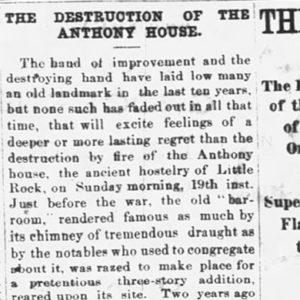calsfoundation@cals.org
Anthony House
From 1830 until 1875, a premier hotel stood on the southwest corner of Markham and Scott streets in Little Rock (Pulaski County). It was known by different names throughout its existence, but it is best remembered as the Anthony House. The location in the heart of downtown Little Rock with frontage on Markham Street put the hotel in an excellent location for travelers, and for many years it also served as stagecoach offices.
Major Nicholas Peay arrived in Little Rock in 1825. He rented a house and opened a tavern. In 1829, he purchased lots on the southwest corner of Markham and Scott streets. In 1830, he built a one-story frame building on Markham Street that he opened as a tavern and hotel. He soon added a one-story connecting brick building to use as a bar on the west side of the first building. Two more connecting one-story frame buildings were added as more rooms were needed. This first collection of buildings was simply known as Peay’s Hotel.
By 1839, Peay and his son-in-law William F. Pope had built a three-story brick building fronting on Markham Street using the two central frame buildings as a base for the new one. The one-story brick building continued as the bar. Mayor Samuel Trowbridge leased the hotel in 1839, by this time known as the American Hotel. In 1841, Major James C. Anthony and his son Phillip purchased the hotel and changed the name to the Anthony House. At some point, a brick ice-house, a brick meat house, and brick stables were added behind the hotel.
In 1844, the Anthony House was offered for sale. The hotel was described as being 64′ x 58′ with “twenty-two commodious bedrooms, and an attic that could be fitted for chambers,” as well as a two-story portico in the rear. The dinning room was 60′ x 24′. While waiting for a buyer, the hotel was leased to John Brown. Brown also leased the second and third floors and the “garret” of a 40′ x 60′ brick building across the alley from the hotel to convert into additional bedrooms for the hotel.
In 1845, Brown advertised that he had refurbished all the rooms, acquired the finest liquor available, and installed billiards tables in the bar. Further, the stage lines stopped at his door, he had carriages and horses available for hire, and he had hacks and porters always available at the steamboat landing. At first, guests staying in the addition had to use the staircase on Markham Street to reach their rooms, but a passage was later built over the alley connecting the two three-story buildings at the second-story level.
Several others leased the Anthony House after Brown. At one time, W. C. Dawson leased the hotel and started calling the hotel the Dawson House, but public sentiment led Dawson to restore the Anthony House name. Over the years, many public events took place at the Anthony House, but it is probably best known for being the headquarters for Elisha Baxter during the Brooks-Baxter War in 1874. A great fire broke out in Little Rock on Sunday, September 19, 1875. It started in a stationery store and soon spread through many other buildings, including the Anthony House. After forty-five years of service to the public, the Anthony House—including the addition across the alley—was destroyed.
For additional information:
Arkansas Gazette. Centennial issue, November 7, 1931.
Kent, Carolyn. “The Anthony House, a Memorable Little Rock Hotel of the 19th Century.” Pulaski County Historical Review 60 (Summer 2012): 42–50.
Pope, William F., and Dunbar H. Pope. Early Days in Arkansas: Being for the Most Part the Personal Recollections of an Old Settler. Little Rock: Fredrick W. Allsopp, 1895.
Roy, F. Hampton, Sr., and Charles Witsell Jr., with Cheryl Griffith Nichols. How We Lived: Little Rock as an American City. Little Rock: August House, 1984.
William E. Woodruff Papers. Jacob Brown Files. Arkansas State Archives, Little Rock, Arkansas.
Carolyn Yancey Kent
Jacksonville, Arkansas
 Anthony House Article
Anthony House Article 




Comments
No comments on this entry yet.